IMPACT
OCPYC Leads Efforts to Improve Outdoor Learning Environments in Orange County’s Child Care Centers
On a hot summer morning, a small group assembles outside of University Child Care Center in Chapel Hill. But it’s not a crowd of parents dropping off their children – the people in this group hold cameras and blueprints, peer down to get a good look at the plants outside the entrance, gaze approvingly at the center’s walkway, and peek through the gate at the park-like play area in front of the center.
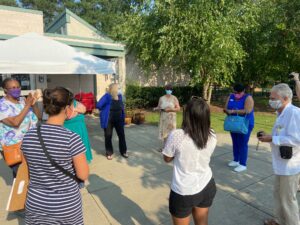 The group – which includes representatives from NC State University’s Natural Learning Initiative and the North Carolina Partnership for Children – is here to see the results of several years of collaborative work the Orange County Partnership for Young Children (OCPYC) has led improving Outdoor Learning Environments (OLEs) at child care centers in Orange County.
The group – which includes representatives from NC State University’s Natural Learning Initiative and the North Carolina Partnership for Children – is here to see the results of several years of collaborative work the Orange County Partnership for Young Children (OCPYC) has led improving Outdoor Learning Environments (OLEs) at child care centers in Orange County.
The work is part of the Healthy Starts for Infants and Toddlers: Shape NC program (HSIT). HSIT promotes nutrition and active learning through play for children ages birth to three years old, focusing on the time when early brain development is critical for children’s lifelong language and learning skills.
The program model provides a network of experts to focus on child nutrition, physical activity, outdoor learning, and breastfeeding/infant feeding. As part of HSIT, OCPYC provided extensive technical assistance, professional development, and training in each of the program areas for directors and classroom teachers at five child care centers in Orange County. OCPYC staff worked intensively with HSIT site directors and NLI staff to plan and design improved infant and toddler Outdoor Learning Environments (OLE) at each center.
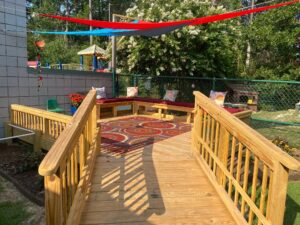 Back at University Child Care Center, the group starts by visiting the brand new infant and toddler OLE, immediately adjacent to the youngsters’ classrooms and directly accessible by a see-through door. Inside, children peer through the door, enjoying the view of the beautiful outdoor space. A few short months ago, this was a weedy patch of grass. Now, the space is anchored by a shaded play deck with an age-appropriate ramp and railings.
Back at University Child Care Center, the group starts by visiting the brand new infant and toddler OLE, immediately adjacent to the youngsters’ classrooms and directly accessible by a see-through door. Inside, children peer through the door, enjoying the view of the beautiful outdoor space. A few short months ago, this was a weedy patch of grass. Now, the space is anchored by a shaded play deck with an age-appropriate ramp and railings.
The OLE includes a covered swing rocker, plants, flowers, trees, and ample space for children to walk, run around, and play with the toys scattered throughout the area.
“Our collaborations with the OLE project on our Infant and Toddler playgrounds have been transformational for our program,” says Jeanne Wakefield M.Ed., the recently-retired director of University Child Care Center. “Not only have we been able to create very beautiful spaces for the children, but we have also learned so much about how playground design can affect how adults and children move about the outdoor space and interact with their environment and with each other. As a result, the children in our program move more for better health, enjoy beauty and nature, and teachers move about the outdoor spaces more naturally and comfortably to interact with the children while they play.”
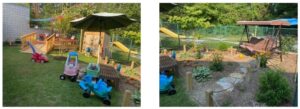
Above: University Child Care Center’s new infant and toddler OLE.
Maria Hitt is OCPYC’s Director of Health Initiatives, and has led Orange County’s Shape NC and HSIT activities since 2009. “Over the past decade we have seen dramatic changes in the OLEs of 15 centers across our county. The OLEs we create have multiple elements for play and exploration, like play houses and mud kitchens; riding pathways to encourage physical activity and movement; and growing plants, trees and gardens to provide shade, interest and learning opportunities. These additions make the spaces more welcoming for children and teachers alike so they want to spend more time outside, where they tend to move more and explore the world in the process,” says Hitt.
Across town, the group has moved on to Spanish for Fun Academy, another HSIT site. “Bienvenidos! Welcome!” calls out center director Adriana Martinez, making her way past the watermelon and sunflower plants in the center’s front green space. She leads the group towards raised beds where children are giving a tour of the tomatoes, squash, and other plants they tend with pride. “Mira!” (“Look!”) one yells joyfully, pointing at a ripe tomato and beaming.
The group moves into the center’s expansive backyard, a shaded oasis with a wooden circular track for riding toys, different areas for active play and learning, a small soccer field, and a raised infant/toddler play deck. Spanish for Fun Academy is a HSIT mentor site, and Academic Coordinator Claudia Muñoz describes the transformation that the center has undergone through their multi-year involvement in HSIT and its parent program, Shape NC.
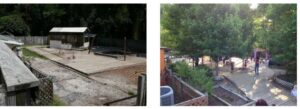
Above: before and after photos of Spanish for Fun Academy’s outdoor space.
“There has been a huge impact on our children, teachers, and parents. Everyone knows that the environment affects children’s development. Our outdoor space is also a classroom where children can take care of plants and observe animals, insects, butterflies, and the changing of seasons. Exposing children to these natural experiences helps them grow in relationship to themselves and nature. We compost, we used recycled milk jugs to water plants, if we care for the plants then we can harvest, and even share our harvest. Every day our outdoor space fills us with wonder and allows the children to become aware of what nature really is,” says Muñoz.
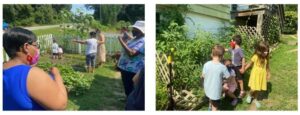 Above: gardening beds in Spanish for Fun Academy’s OLE.
Above: gardening beds in Spanish for Fun Academy’s OLE.
The North Carolina Partnership for Children (NCPC) is developing the HSIT and Shape NC model. Stephania Sidberry, Shape NC Manager for NCPC, was part of the group that day. “These centers have experienced such amazing transformations since the beginning of the project in 2018, both inside and out. As I toured these OLEs, I was most struck by the energy and investment of the center directors in getting these OLEs completed before the end of the grant. COVID-19 really deterred progress for much of 2020, but the center directors persevered and the OLEs are now nearing completion,” says Sidberry.
The involvement of NC State University’s Natural Learning Initiative (NLI) was instrumental in designing the OLEs. NLI staff co-created the design plans with center directors and provided support along the way to completion. Dr. Nilda Cosco, NLI’s Director of Programs, was also on the tour that day.
“These projects are critical for child development, especially children who live in communities where nature is not present, or families who do not feel safe outdoors. Site naturalization (adding trees, and fruit and vegetable gardens) increases diversity and supports physical activity, healthy eating, and outdoor learning. Natural play areas also support the immune system and well-being of children and teachers. We were impressed with the commitment of directors to implement the outdoor renovations as they were struggling with pandemic adverse circumstances. They understand the impact of outdoor play and learning on child development and children’s health,” says Dr. Cosco. One only has to look at the smiling faces of the children at the centers to know how true that is.
————
The Orange County Partnership for Young Children (OCPYC) is a funder, convener, organizer, trainer, and advocate for young children’s healthy growth and development. OCPYC’s mission is to ensure that all young children in Orange County arrive at kindergarten healthy and ready to succeed. Learn more at http://www.orangesmartstart.org/.
Shape NC: Healthy Starts for Young Children is an initiative of Blue Cross and Blue Shield of North Carolina (BCBSNC) Foundation, The North Carolina Partnership for Children, Inc. (NCPC), and the Corporation for Community and National Service, created to increase the number of children starting kindergarten at a healthy weight and ready to learn. Learn more at https://www.smartstart.org/shape-nc-home/.
